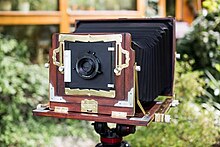Vageeswari camera

Vageeswari cameras were large format cameras made in India. They were the first field camera manufactured in India and were recognised globally. Vageeswari cameras were designed and manufactured by K. Karunakaran, an Alappuzha-based technician.[2][3]
Cameras were named after the goddess Saraswati. The first camera came with a price tag of Rs 250.[4] It was also used in forensic departments.[5]
History[edit]
In 1942, Padmanabhan Nair, a photo studio owner, asked Kunju Kunju Bhagavathar, a musician, to fix his camera's torn bellows. Bhagavathar was able to fix it. Nair then suggested Bhagavathar to make a camera but he declined. However his son, Karunakaran, took on the challenge. He started asking about the details of a camera and even travelled to Chennai, Bangalore and Mumbai to learn more about camera's working. He deconstructed an old camera and then put it back together.[6]
In 1946, Karunakaran finally built the first Vageeswari camera. It was on par with foreign cameras and its price was a fraction of foreign camera. They were an instant hit. By 1950, Karunakaran manufactured between 50-100 cameras per month and employed 30 people. By 1960s, he also got orders from Germany and Sri Lanka.[6][4]
By 1980s, Vageeswari started becoming obsolete as the market started favouring compact cameras. In 1995, manufacturing of the Vageeswari completely stopped. In April 2016, K Karunakaran, aged 90, passed away.[6][7][8]
The camera has seen a revival in attention.[9] In 2021, Lokame Tharavsdu exhibition was held where Anu John David, a photographer showcasted Vageeswari cameras and photographs.[4] People like Satheesh Nair are now restoring Vageeswari cameras.[5]
Construction[edit]
The body was made of teak. Brass and aluminium knobs as well as Nettlefold screws held the frame together. German lenses were attached to a leather bellow. The cameras were entirely assembled by hand. Eight variants were produced that included small cameras that were used to make a maximum of four passport-size photos.[10]
See also[edit]
References[edit]
- ^ "Restoration of a Vageeswari View Camera – Fotografie". Christian Klant. 13 August 2014. Retrieved 2016-04-20.
- ^ "The unsung hero who invented Vageeswari camera". ManoramaOnline. Archived from the original on 2016-04-22. Retrieved 2016-04-20.
- ^ Narayanan, Chitra (2021-08-18). "Turning the lens on the most iconic camera made in India". BusinessLine. Archived from the original on 2021-09-11. Retrieved 2024-05-28.
- ^ a b c Narayanan, Chitra (2021-08-19). "India's homegrown Vageeswari camera from Alappuzha". BusinessLine. Retrieved 2024-05-28.
- ^ a b "Kerala's iconic Vageeswari camera gets a second shot". Mintlounge. 2022-01-30. Retrieved 2024-05-28.
- ^ a b c Gupta, Nidhi. "Vageeswari: A made in India camera that left an impression". Croma Unboxed. Archived from the original on 2024-05-28. Retrieved 2024-05-28.
- ^ Service, Express News (2016-04-20). "Inventor of Vageeswari Camera Passes Away". The New Indian Express. Retrieved 2024-05-28.
- ^ "ലോകം കീഴടക്കിയ ആലപ്പുഴ 'വാഗീശ്വരി'". ManoramaOnline. Archived from the original on 2016-07-27. Retrieved 2024-05-28.
- ^ Hall, Amy Cox (2020-11-29). The Camera as Actor: Photography and the Embodiment of Technology. Routledge. ISBN 978-1-000-18252-1.
- ^ Jacob, Mahima Anna (2022-02-11). "Chin up for history". The New Indian Express. Retrieved 2024-05-28.
